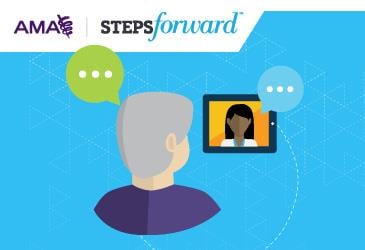When you think of telemedicine, what comes to mind? Often the answer is a split screen—physician and patient in separate locations on their computers or tablets. But one health system has shown the true breadth of telemedicine’s reach by using the technology to treat patients during the critical early moments of a stroke. Find out how.
The risk of damage and disability in patients who are experiencing a stroke increases with any delay in care delivery. Two emergency physicians at the University of Virginia (UVA) Health System understood the need for speed when it comes to caring for patients in the midst of acute stroke and designed a streamlined telemedicine system to begin treatment on way to the hospital.
Nina Solenski, MD, and Andy Southerland, MD, designed the “telestroke” model using low-cost, “off-the-shelf” technology: A mobile device, 4G commercial broadband and HIPAA-compliant encrypted software for patient privacy.
How the “telestroke” model works
The portable system is deployed in the ambulance to facilitate a livestream neurological exam with the remote on-call neurologist during the ambulance ride to the hospital. Valuable time is saved by enabling treatment prior to the patient’s arrival at the ED.
These systems are “really designed to help support patients from rural communities to get the care they need quickly,” said David Cattell-Gordon, director of the UVA Telemedicine Office. “With a stroke, every minute matters. With this telestroke model, we’re applying the blazing speed of the Internet to life-saving decisions about therapy while patients are en route to the hospital.”
As the patient arrives at the ED, pulling a Stat-Pak® envelope rapidly activates an acute stroke alert. The envelope contains a pilot list of instructions for each member of the care team. A single toll-free phone call alerts the remote telestroke neurologist so that live videoconferencing with the patient and family can start within minutes. Telemedicine technicians in the background continuously monitor the audio-video quality and facilitate the transmission of vital brain CT scan images.
“We are in a golden age of mobile telecommunications,” Dr. Southerland said. “We can take advantage of these rapidly evolving media to effect change in medicine. We were able to reach out more rapidly to acute stroke patients in low-access areas … before they ever reach the hospital.”
Learn how to adopt telemedicine in your practice
A new module from the AMA’s STEPS Forward™ collection can help you use telemedicine in your practice. In the module, you will find the four steps you need to adopt telemedicine and navigate the benefits and challenges of remotely monitoring patients.
Visit AMA Wire® for answers to your telemedicine questions and to see how the AMA is addressing the top telemedicine issues. Also, learn the three ways physicians are prepping for telemedicine’s success, and find out why one health insurer is embracing telemedicine.
You also can take some of your team members to the AMA-MGMA Collaborate in Practice Meeting, March 20-22 in Colorado Springs, to gather leadership techniques to help propel you and your practice team toward future success. Former U.S. Sen. Bill Bradley, D-N.J., and Richard Deem, AMA senior vice president of advocacy, will speak on leadership and the changing health care landscape. Register online, and receive a discount when you register two or more of your team members.
More than 25 modules are available in the AMA’s STEPS Forward collection, and several more will be added later this year, thanks to a grant from and collaboration with the Transforming Clinical Practices Initiative.




